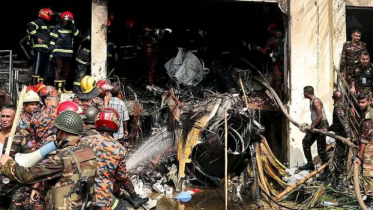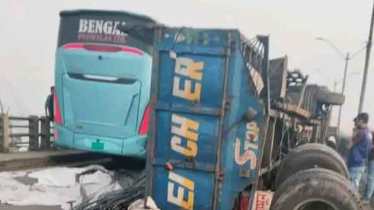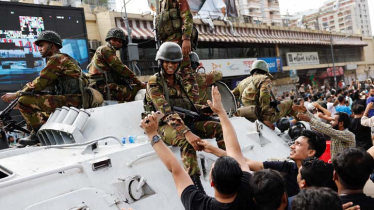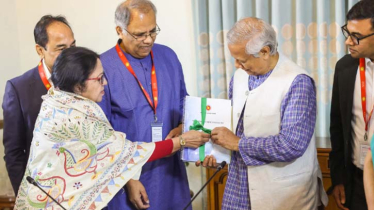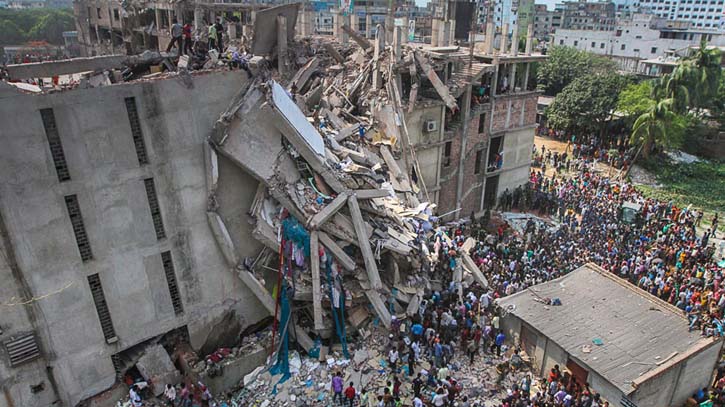
Photo: Collected
Ten years have passed since the tragic collapse of Rana Plaza, a multi-story building in Savar, Bangladesh, that housed five garment factories. The incident, which occurred on April 24, 2013, resulted in the deaths of over 1,136 garment workers and left nearly 2,438 others injured.
Despite the passage of time, many of the injured workers are still struggling to return to normalcy, as they have not received proper treatment for their injuries.
Ten years have passed since the horrific industrial disaster that shocked the world and the country's RMG sector has seen significant improvement, but the process of ensuring justice for the deaths -- caused due to the negligence has been sluggish.
Labour leader Lovely Akter lamented the lack of proper treatment for the surviving victims of the Rana Plaza tragedy.
She pointed out that while compensation has been provided to the families of the deceased workers, those who survived but sustained severe injuries have not received adequate medical care. As a result, many of them continue to suffer and are physically disabled. Akter further criticised the current State Minister for the Ministry of Disaster Management and Relief, accusing him of forgetting the victims and failing to provide assistance for their treatment.
In addition, to proper medical treatment, labour rights organisations are demanding accommodation for the injured victims within the Rana Plaza premises.
Ruhul Amin, a victim who lost his leg in the accident, shared his disappointment at not being able to receive the necessary plastic surgery or an artificial leg even after a decade. He cited financial constraints as the reason for discontinuing his treatment, highlighting the lack of support for injured workers.
Fatema, who lost her hands in the collapse and was rescued from the rubble, also expressed dissatisfaction with the quality of treatment she received. She stated that she has not been able to lead a normal life due to inadequate medical care.
Despite claims by the Bangladesh Garment Manufacturers and Exporters Association (BGMEA) that the victims have received support, including financial assistance from the association and the garment factories housed in Rana Plaza, the victims and their families continue to face challenges in accessing proper medical care and rehabilitation.
On the anniversary of the Rana Plaza tragedy, leaders and activists from various labour organisations gathered at the site to honour the memory of the victims and raise demands for worker rights and accountability for the culprits.
The demands include maximum punishment for all those responsible, including Rana Plaza building owner Sohel Rana, an immediate wage board for the 40 lakh (4 million) garment workers representing the deceased workers of Rana Plaza, and a wage of Tk 25,000 for workers. Other demands include a 60 percent allowance until the wage increase, long-term medical care and necessary rehabilitation for injured workers, proper conservation and permanent memorial construction at the site of the collapsed building, the formation of an emergency fund for all workers, and the closure of all factories as part of a mourning and safety day on April 24.
The tragic events of Rana Plaza continue to haunt the survivors and their families even after a decade. Despite promises and efforts by various stakeholders, including the government, garment industry associations, and labour organisations, the injured workers have not received adequate medical care and support for their rehabilitation.
The lack of proper treatment has left many of them physically disabled and struggling to lead normal lives. It is imperative for all stakeholders to work together to address the ongoing challenges faced by the victims of Rana Plaza and ensure that they receive the necessary medical care, rehabilitation, and support they need to rebuild their lives. Only through concerted efforts can we prevent similar tragedies from occurring in the future and ensure the safety and well-being of all workers in the garment industry.
TDM/MI


